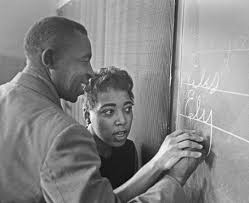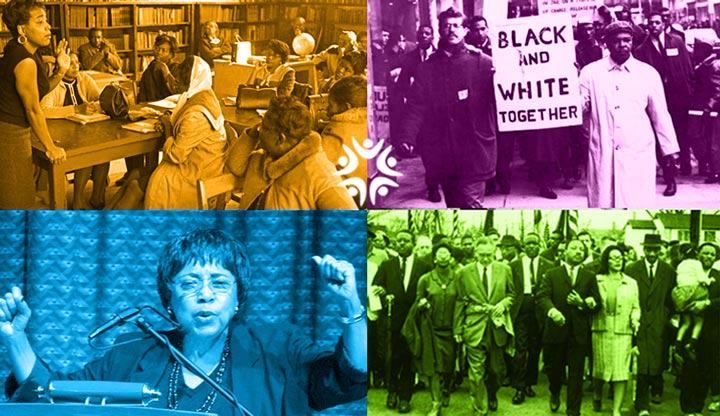The Citizenship Education Program (CEP)
Background about the Citizenship Education Program
Citizenship as a Verb: Citizenship is not only a legal status; we think of “citizenship” as a verb, that is, a mindset, an attitude that implies action, like participating, assisting, speaking out, resisting, influencing, leading, organizing, cooperating, collaborating, dissenting, rejoicing.
The late Dorothy Foreman Cotton’s work encouraged people to understand that as citizens, born or naturalized in the US, they had constitutional rights. But beyond citizenship as a legal status, Dorothy Cotton Institute views citizenship as a verb, engaging and influencing your society. Democracy is the right of all people living here to insist on government of, by and for the people. That requires the will and courage to get involved, speak out, influence policy, expand rights and protections, and change situations. For more about the Applied Civics Lab and Civic Academy, click here.
The Citizenship Education Program (CEP) was the flagship program of the Southern Christian Leadership Conference (SCLC). It employed the principles of nonviolence and the methodology of popular education, a highly effective, “learner-centered” participatory process developed by Esau Jenkins and Septima Clark with Myles Horton at the Highlander Folk School, and later adopted by the SCLC and led by Dorothy Cotton, Andrew Young and Septima Clark.
CEP participants were living and working under the daily threat of violence and retaliation for attempting to register to vote. The education staff of the SCLC drove a bus over several southern states, picking up respected local grassroots community leaders and activists, inviting them to participate for free in a 5-day intensive in Dorchester, GA. Their transportation, lodging and meals would be paid for. Classes might have 25-50 or more participants, who would begin getting to know one another and then be immersed in a program that might address basic literacy and relevant vocabulary, how to pass the test for voter registration, how to fill out forms, e.g., a money order, but the design emerged in relation to what people said they needed to learn. People came to the CEP with different levels of education and the program was adapted to meet their needs and interests.
One of the first CEP discussions happened when Dorothy asked participants to talk about “What is a citizen?” “What is citizenship?” Then people began to share stories of the challenges and suffering they faced under segregation, threats and intimidation. Often people discovered that folks in other states, other communities, were experiencing very similar kinds of mistreatment and abuse. They found common experience, empathy, and connection.
After listening to people share their pain, anger and sense of hopelessness about the barriers they encountered, the goal shifted to focus on what they could do about it, asking provocative questions like “If things are set up to treat you so badly, who is making these decisions?” “Who gets to decide?” and “Why aren’t you in charge?” The goal was to encourage a shift in participants’ mindset– from “victim” to “citizen”—from despair, passivity and helplessness to determination, self-confidence and agency. With the encouragement and support of others, participants left with a plan of action.
People were asked “What is the Constitution?” “What are Amendments?” They were introduced to important Constitutional Amendments and the specific rights they afford citizens. The CEP staff soon learned that, out of necessity, people who have been illiterate all of their lives, or semi-illiterate (barely able to read or write), often have developed remarkable abilities for memorization. They memorized and could quote whole sections of the Constitution. Participants examined the implications of the rights they had been denied. Being second-class citizens without political power. At some point mid-week, Dr. King and would come to the program and teach about nonviolence, why nonviolence is difficult and requires great self-discipline and commitment but can be very powerful. They learned the principles of nonviolence and the steps of a nonviolent campaign, useful and effective means of expressing dissent, and petitioning for redress of grievances.
 The entire week included shared meals, playing games, singing, laughing, creating friendships. Some folks learned to write their name in cursive (longhand) so that they could sign the voter registration application. CEP participants went home with the tools of basic literacy, and a plan for a nonviolent campaign to organize, educate, register to vote, demonstrate, march, sit in, strike, and end legalized racial segregation. Many participants were asked to become CEP teachers and were given training, coaching, and support to set up Citizenship/freedom schools in their own communities. Fanny Lou Hamer, Victoria Gray Adams, Annell Ponder, Amelia Boynton, Annie Devine, Lula Williams, Bernice Robinson and many others led citizenship schools that produced highly effective activists and citizens who later ran for office and won.
The entire week included shared meals, playing games, singing, laughing, creating friendships. Some folks learned to write their name in cursive (longhand) so that they could sign the voter registration application. CEP participants went home with the tools of basic literacy, and a plan for a nonviolent campaign to organize, educate, register to vote, demonstrate, march, sit in, strike, and end legalized racial segregation. Many participants were asked to become CEP teachers and were given training, coaching, and support to set up Citizenship/freedom schools in their own communities. Fanny Lou Hamer, Victoria Gray Adams, Annell Ponder, Amelia Boynton, Annie Devine, Lula Williams, Bernice Robinson and many others led citizenship schools that produced highly effective activists and citizens who later ran for office and won.
The CEP trained thousands to use nonviolent direct action and civil disobedience for liberation from what Dorothy called “American-style apartheid” in the Jim Crow south. CEP teachers like Amelia Boynton and Lula Williams helped organize the marchers from Selma to Montgomery, and Dorothy Cotton and others organized the Children’s Crusade in Birmingham, Alabama and the desegregation of the beaches in St. Augustine Florida. Fanny Lou Hamer, Victoria Gray and Annie Devine started the Mississippi Freedom Democratic Party. The CEP equipped people to engage in effective, determined action, despite the real threat of retaliation, violence, dogs, fire hoses and jail.
While Dorothy was still alive, DCI Senior Fellows worked with her to design the Citizenship Education Program for the 21st Century. We are working now to update the content and tools to be meaningful and relevant for the kinds of change needed now and the interests of change-makers today, e.g., the need to address digital literacy, the connection between technology and media, and how information and organizing are shared now. Stay tuned!

